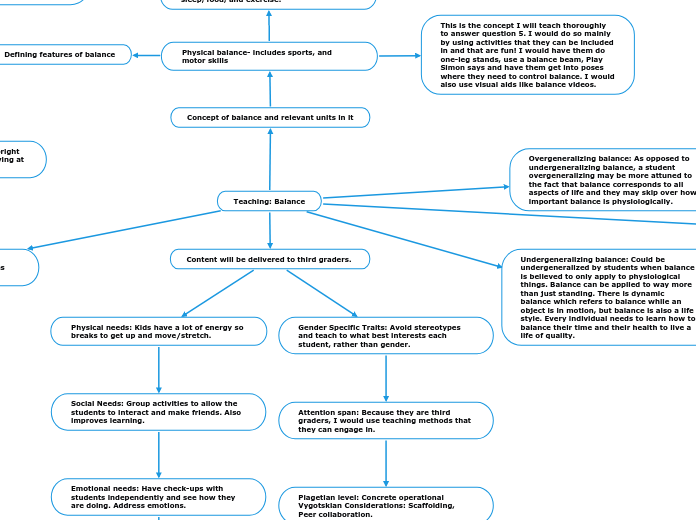Teaching: Balance
Balance can be integrated into many diverse subjects, skills, and perspectives across various curricular activities.
Content will be delivered to third graders.
Physical needs: Kids have a lot of energy so breaks to get up and move/stretch.
Social Needs: Group activities to allow the students to interact and make friends. Also improves learning.
Emotional needs: Have check-ups with students independently and see how they are doing. Address emotions.
Academic needs: Use different teaching styles and go at a pace that allows for teaching amongst the whole classroom. Use scaffolding and tutoring if needed.
Gender Specific Traits: Avoid stereotypes and teach to what best interests each student, rather than gender.
Attention span: Because they are third graders, I would use teaching methods that they can engage in.
Piagetian level: Concrete operational Vygotskian Considerations: Scaffolding, Peer collaboration.
Concept of balance and relevant units in it
Physical balance- includes sports, and motor skills
Health: Managing and balancing things like sleep, food, and exercise.
Work-Life balance: Balancing time between what needs to be prioritized and. Balancing wants and needs.
This is the concept I will teach thoroughly to answer question 5. I would do so mainly by using activities that they can be included in and that are fun! I would have them do one-leg stands, use a balance beam, Play Simon says and have them get into poses where they need to control balance. I would also use visual aids like balance videos.
Defining features of balance
Physiological balance
Equilibrium: refers to all forces canceling each other out to provide a center of balance. Example: A book sitting on a table.
Physical contributions to balance: Somatosensory, vestibular, vision. For example: An elephant uses all these things to stay upright.
Dynamic balance, refers to staying upright while moving. For example: a car moving at a stable velocity.
Two concepts are dynamic and static balance
Non examples of these two concepts:
Dynamic balance: Sitting still, wall sits, a light pole that doesn't move.
Static balance: A moving car, a child running, a frisbee flying through the air.
Static balance: Involves staying upright while standing still. For example: Humans watching a sports game and standing on the bleachers.
Undergeneralizing balance: Could be undergeneralized by students when balance is believed to only apply to physiological things. Balance can be applied to way more than just standing. There is dynamic balance which refers to balance while an object is in motion, but balance is also a life style. Every individual needs to learn how to balance their time and their health to live a life of quality.
Overgeneralizing balance: As opposed to undergeneralizing balance, a student overgeneralizing may be more attuned to the fact that balance corresponds to all aspects of life and they may skip over how important balance is physiologically.
What could lead to misconceptions:
Simpleness: Balance can seem like a simple topic when in reality it is very complex.
Ignoring trade-offs: Balancing priorities in life often includes needing to trade something, for a lack of better terms, sacrifice. Students may overlook the important tendency to do so.
Media portrayals: Media often portrays balance and motor skills in extreme ways. For example, kung fu movies and movies where superpowers are involved. It is important to know that many of those movements are not real and/or require help from a third party.
